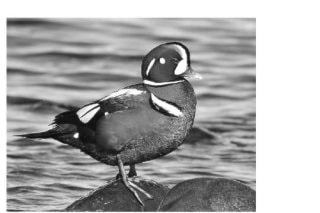“Histrionicus histrionicus” translated from Latin means “stage player or actor,” and the Italian version describes characters in a comedy that wear masks and oddly painted costumes.
Harlequin ducks certainly look the part, in their brilliant plumage, and they act the part too, earning themselves the moniker “clowns of the duck world.” They are expert boatmen, able to negotiate their way up freshwater currents or surging ocean surf.
There are two distinct populations of harlequins in North America. The Pacific coast populations winter from Alaska to southern Oregon, but migrate east of the coastal mountains to breed in the pristine, fast-running streams and rivers. The much smaller Atlantic populations winter from Nova Scotia south along the coast to Maine and Virginia; spring sees them migrating north from Newfoundland to Greenland and the Arctic.
Harlequins are small sea ducks about half the size of the common mallard; they have round heads, stubby bills and stocky bodies. They are one of the easiest ducks to see in the winter, as they prefer to feed close to the shore. Harlequins can be seen along the shorelines in the Comox Valley and Campbell River, and Qualicum Beach is a favourite haunt.
The male is one of nature’s most exquisitely marked birds, rivalling the wood duck and eider. The belly and wings are slate blue with chestnut flanks outlined very distinctively with white stripes; they also have a noticeable crescent-shaped white patch at the base of the bill and an ear patch. In comparison, the females are “plain Janes” — their overall appearance is brownish-grey, but they do have three white patches on either side of their heads.
Harlequin ducks tend to stay close to shore and can usually be seen in more rocky areas, gaining the name “rock ducks” as they like to haul out onto the rocks to rest from feeding. Extremely dense layers of feathers trap air, providing them with exceptional insulation against the cold water and also making them very buoyant, allowing them to bob like corks in the turbulent water.
Winter food for these ducks includes small crabs, snails, limpets, mussels and fish eggs, and they are especially partial to the herring spawn. The ducks dive for some prey in shallow water, or they will pry shellfish from nooks and crannies in the rocks.
In late April, the local harlequins start their migration inland; many will return to Banff National Park which provides the clear, unpolluted, fast-moving water these ducks need in order to successfully breed. Often their route will take them up narrow, rushing streams which they navigate on their large powerful feet to walk or swim upstream against the current; they will often have to take a detour on land to bypass rapids.
Freshwater food includes a variety of flies such as black flies, mayflies and stoneflies, supplemented with fish eggs. These ducks have very high food requirements — expending a lot of energy together with a high metabolism makes it necessary for them to spend a great deal of the day feeding, and they lack the ability to store fat like the larger ducks or geese.
Little is known of harlequins’ mating rituals and they are very secretive, especially in the location of their nests. Nests are built beside fast-flowing water far from human disturbance; they are well-hidden under vegetation or logs, up in tree cavities or even on rocky ledges.
As soon as the eggs are laid, the male abandons the family and heads back to the coast. Once hatched, the ducklings are able to swim within 24 hours, but stay with the mother to gain their hunting and survival skills for another 50 days before they can fly.
It was a bittersweet moment at MARS when we rescued a harlequin duck last week, the first ever admitted to the centre. Unfortunately, the duck sustained a fatal injury to its bill and jaw, probably the result of one of our many storms.
As with so many waterfowl, severe winds and storms can disorient the birds and they see what appears to be the ocean, but is in fact the light shining off the wet road which they attempt to land on — not a happy landing.
Harlequin ducks are listed as an endangered species in eastern Canada, and yellow-listed in B.C. As these ducks are indicators of healthy, pristine environments, there is concern in the Atlantic and eastern areas where populations have dramatically declined. This decline is attributed to increased urban pollution from oil, acid rain, expanding urban areas and recreational activities.
Yet again, it reminds us just how vulnerable all wildlife species are becoming (this year’s oil spill in the Gulf was a real wake-up call), and how we must do our part to make sure we preserve their habitat.
When walking along our shores, keep dogs on a leash, as it is especially important that these ducks remain undisturbed when feeding, and they need constant calorie intake to survive the winter. Also, do not feed ducks, geese or swans leftover bread.
For more information about MARS, visit www.wingtips.org; to report injured wildlife, call 1-800-304-9968.
Sandy Fairfield is the educational co-ordinator for the Mountainaire Avian Rescue Society (MARS). The MARS column appears every second Friday.
